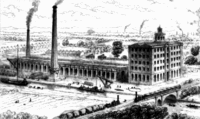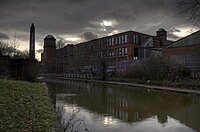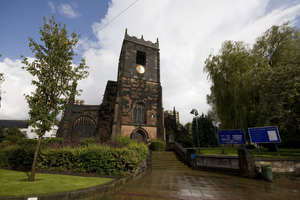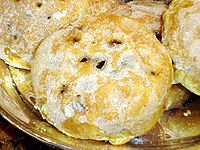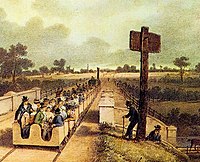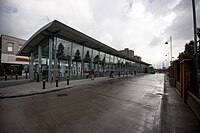Eccles
| Eccles | |
| Lancashire | |
|---|---|
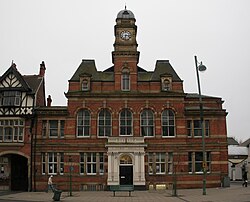 Eccles Town Hall | |
| Location | |
| Grid reference: | SJ778986 |
| Location: | 53°28’57"N, 2°20’20"W |
| Data | |
| Population: | 36,610 (2001) |
| Post town: | Manchester |
| Postcode: | M30 |
| Dialling code: | 0161 |
| Local Government | |
| Council: | Salford |
| Parliamentary constituency: |
Salford and Eccles |
Eccles is a town in southern Lancashire, three miles west of Salford and four miles west of Manchester city centre. Eccles is on sloping ground between the M602 motorway to the north and the Manchester Ship Canal to the south. It is a former industrial town, though declined and now a poor place. The town's present-day landscape is dominated by residential tower blocks, forming a stark contrast with the surrounding Victorian terraced housing.
Eccles cake was first made here, named after the town.
The town grew up around the 13th-century Parish Church of St Mary. Evidence of prehistoric settlement has been discovered locally but the area was predominantly agricultural until the Industrial Revolution, when a textile industry was established in the town. The arrival of the Liverpool and Manchester Railway, the world's first passenger railway, led to the town's expansion along the route of the track linking those two cities. The twentieth century however saw an industrial decline.
Contents
Name
The derivation of the name is uncertain, but several ideas have been proposed. One is that the "Eccles" place–name is derived from the British language Ecles or Eglys, meaning “church”, a word derived from the Latinised Greek Ecclesia.[1] Several pre-English place-names remain in Lancashire, though usually for rivers and hills. Tge root ‘’ecles’’ survives in a number of village names.
Kenyon's "Origins of Lancashire" (1991) suggests alternatives but there is no other leading theory.[1]
History
Early history
Pre-historic finds in the parish of Eccles include dugout boats found at Barton-upon-Irwell, an arrowhead, a spear, and axes at Winton, which taken together appear to suggest the existence of a hunting and travelling society. Habitation in the area may extend as far back as 6000 BC, with two separate periods of settlement on Chat Moss, the first around 500 BC and the second during the Romano-British period.[2]
The Manor of Barton-upon-Irwell once covered a large area; in 1276 it included townships such as Asphull, Halghton, Halliwelle, Farnword, Eccles, Workedele, Withington (latterly Winton), Irwelham, Hulm, Quicklewicke, Suynhul, and Swinton. Before this date it would appear to have been even larger, but by 1320 the manor boundaries were described as "Tordhale Siche descending to Caldebroc, then to the pit near Preste Platteforde and then to another pit, then to the ditch of Roger the Clerk, then to the hedge of Richard the Rimeur, then following the hedge to Caldebroc."[3] The manor was originally controlled by the Barton family until about 1292 when by marriage it came into the ownership of the Booth family, who retained it for almost 300 years. In 1586 the Trafford family assumed control of the manor, and established themselves in 1632 at Whittleswick, which was renamed Trafford Park.[4]
The parish of Eccles anciently contained the townships of Barton-upon-Irwell, Clifton, Pendlebury, Pendleton and Worsley.[5] Toward the end of the Middle Ages the parish had an estimated population of about 4,000 Communicants. Agriculture remained an important local industry. Local cottage industries included blacksmiths, butchers, thatching, basket weaving, skinning and tanning. Weaving was popular, using linen and wool. Merchants traded in corn, and badgers (buyers) bought and sold local produce.[6]
Although the local gentry supported the Royalists, the English Civil War had little effect on the area. Troops would occasionally pass through the parish[7] and there was a skirmish at Woolden,[8] but the only other mention of local involvement was the burial of two (probably) local soldiers in 1643.[7] The Jacobite army passed through in 1745, in its advance and subsequent retreat.[8]
Textiles and the Industrial Revolution
In 1795 John Aikin described the area:
The agriculture of the parish is chiefly confined to grazing, and would be more materially benefited by draining; but the tax upon brick, a most essential article in this process, has been a very great hindrance to it. The use of lime—imported from Wales, and brought by the inland navigations to the neighbourhood of our collieries—has become very general in the improvement of the meadow and pasture lands.[8]
During the 18th century the predominance of textiles in the region is partly demonstrated in the parish registers of 1807, which show that 46 children were baptised with 34 fathers employed as weavers.[9] In Memoirs of seventy years of an eventful life (1852) Charles Hulbert wrote:
"The principal employment of the working population of Eccles and vicinity at that time, was the manufacture of Cotton Goods on the home or domestic plan. These were not then, according to my present recollection, more than two Spinning Manufactories in Manchester, Arkwright's with its loft chimney, and Douglas's extensive Works, on the River Irwell, near the Broken bank ... At the period of my first residence in Eccles Parish, I believe the above Mills chiefly supplied the Weavers of Eccles and other parishes with twist for warps, which were purchased by the Master Manufacturers."[10]
During the early 19th century the growth of industry meant the majority of the area's inhabitants were employed in textiles or trade, while a minority worked in agriculture. The factory system was also introduced; in 1835 1,124 people were employed in cotton mills, and two mills used power looms. Local hand-produced specialities included striped cotton ticks, checks, Nankeens, and Camrays. Two cotton mills are visible on the 1845 Ordnance Survey map of the area. The area also became renowned for its production of silk, with two mills at Eccles and one at Patricroft. Many factory workers were children under 12 years of age.[11]
In 1830 the Liverpool and Manchester Railway was opened, passing through Eccles, and this was to make a great boost to its prosperity. However, on the very day that the railway opened in 1830, Eccles was involved in the world's fatal first railway accident: William Huskisson, the Member of Parliament for Liverpool, was seriously injured by an approaching locomotive. He was taken to the vicarage in Eccles for treatment, but died of his injuries.
In 1830 James Nasmyth (son of Alexander Nasmyth) visited the newly opened Liverpool and Manchester Railway, and on his return to Manchester noted the suitability of a site alongside the canal at Patricroft for an engineering works.[12][13] He and his brother leased the land from Thomas de Trafford, and established the Bridgewater Foundry in 1836. The foundry was completed the following year with a design based upon assembly line production. In 1839 Nasmyth invented the Steam Hammer which enabled the manufacture of forgings at a scale and speed not seen before. In the same year the foundry started to manufacture railway locomotives, with 109 built by 1853. Nasmyth died a wealthy man in 1890.[14]
The Eccles Spinning and Manufacturing Company came into being following a meeting called by the Mayor of Eccles, in which concern was expressed at the decline in local industry. Two earlier Eccles mills had been destroyed by fire, resulting in significant local unemployment. Designed by Potts, Son and Hennings of Manchester, Bolton and Oldham, it was opened in 1906. The imposing mill contained a multi-storey spinning mill, engine house and extensive weaving sheds.[15]
Early housing in the village consisted of groups of thatched cottages clustered around and near the parish church. The influx of workers from areas around the village accompanied an increased demand for extra housing. Even after the establishment of the local board of health new properties were often built in the gardens of existing dwellings, leading to severe overcrowding. In 1852 the streets were paved with boulders, sewerage was non-existent, and water supply was a local well. During the latter half of the 19th century new housing was erected alongside the railway, and large areas of open land were soon occupied with new housing estates built for the area's more wealthy residents.[16]
The construction of the Manchester Ship Canal provided many local residents with jobs. 1,888 people were employed on the section of the new canal at Barton. A stone aqueduct over the River Iwell dating from 1761 and designed by James Brindley was demolished and replaced by a new moveable aqueduct: the Barton Swing Aqueduct.[17][18]
Post-industrial history
Eccles was not immune to the general decline of the textile industry in the 20th century. The Bridgewater Foundry ceased operations in 1940, taken over by the Ministry of Supply and converted into a Royal Ordnance Factory.[19] The factory closed in the late 1980s, and is now part of the Nasmyth Business Centre.
Eccles is included in the City of Salford's Unitary Development Plan 2004–2016 as part of the western gateway, a major focus for economic development during the plan period. Areas to be developed include the Barton Strategic Regional Site, Dock 9 at Salford Quays, Weaste Quarry near Eccles, and remaining land at Northbank, and the plan provides for improvements which include the A57 – Trafford Park link at Barton and provisional support for a further expansion of the Manchester Metrolink system through the area and a link between the A57 and M62 at Barton. Under this plan the town's retail environment would also be maintained and enhanced.
Sights of the town
The Parish Church of St Mary the Virgin is the only Grade I Listed building in Eccles.[20]
There are two Grade II* listed buildings in the Eccles area:
- The Church of St Andrew was completed by the architect Herbert Edward Tijou in 1879.[21][22]
- Monton Unitarian Church was completed in 1875 by Thomas Worthington.[23]
The town's war memorial was erected in 1925. Local sculptor John Cassidy was commissioned to design the structure. Built from Portland stone and topped with a bronze figure, it was unveiled by Lord Derby in August 1925. It is now a Grade II listed building.[24] Eccles Library was built on a slum clearance site in the town centre. The building was funded by Andrew Carnegie and designed by Edward Potts (who also designed the canalside mill picture above), and opened on 19 October 1907. Designed in the Renaissance style, it is now a Grade II listed building. Potts had hoped that the building would become "the Eccles University".[24][25]
Salford City Council has bid for the Liverpool and Manchester Railway to be included in UNESCO's list of World Heritage Sites. Eccles railway station has undergone restoration work by the Friends of Eccles Railway Station, including clean-ups, renovation of the station garden, and a mural.
Both Monton Green and Ellesmere Park are designated conservation areas, and a Site of Biological Importance is located near Rutland Road and Chatsworth Road.
Churches
As the population of Eccles increased during the Industrial Revolution the mediæval parish of Eccles was gradually divided into smaller parishes, and surrounding townships gained their own churches. Roman Catholics living in Eccles originally attended worship at a chapel on the de Trafford estate, south of the Irwell, however the chapel was demolished and replaced by All Saints Church.
The Grade II listed St Andrew's church in St Andrew's Parish was built in the 1870s and opened in 1879 (the tower was added in 1889). Over the next 40 years various decorative improvements were made to the building, including stone carvings, stained glass, and wall paintings (covered in 1965). Four months after the church was consecrated a church school was opened, the forerunner of the present St Andrew's Primary School. A second school in Monton (then part of the parish) opened in 1881. In 1912 Monton became a separate parish with its own church, St Paul's.[26]
Churches include:
- Church of England:
- St Andrew’s
- St James (at Hope)
- St Paul’s
- Baptist
- Methodist:
- Methodist New Connexion
- Zion Methodist New Connexion
- Wesleyan Methodist
- Roman Catholic: All Saints
Eccles cake
Eccles cakes have brought the name of this Lancastrian town to the world. Eccles cakes were first produced and sold in Eccles in 1793, from a shop owned by James Birch. They are a tradition of the town, made from a recipe of flaky pastry, butter, nutmeg, candied peel, sugar and currants]]
They are sold across the country and exported across the world.
Another Lancashire town, Chorley, has a rather similar rival confection; the Chorley cake.
Transport
The Salford to Warrington turnpike trust was formed in 1752 and assumed control of the road from Pendleton to Irlam. Opinions as to the quality of the road were mainly negative; writing in 1795, John Aikin said "Much Labour and a very great expense of money have been expended on the roads of this parish, but they still remain in a very indifferent state, and from one plain and obvious cause, the immoderate weights drawn in carts and waggons."[27] On the poor quality roads, the Liverpool to Manchester stagecoach took almost an entire day to make the journey. Matters appear to have improved by the 19th century, along with the opening of several more trust roads throughout the parish. In the early part of the 19th century some existing routes were widened and straightened, including the modern-day Regent Road in Salford. All the roads except one were surfaced with boulders.[27] In 1832 a daily omnibus service from Manchester reached Eccles and Pendleton. In 1877, following the laying of tracks in the road, horse-drawn trams were used; these eventually gave way in 1902 to electric trams under the control of the Salford Corporation. Motorised buses were introduced in 1938.[27]
The opening of the Liverpool and Manchester Railway on 15 September 1830 was a pivotal moment in transport history. The world's first railway constructed to carry passengers as well as freight, it signalled the beginning of the end for both the turnpike trusts and the canal system. Stagecoach services ceased as passengers started to use the faster railway.[12] The opening day was historic for more than one reason though; Eccles became a part of an early railway accident. During a stop at Parkside railway station near Newton-le-Willows, Member of Parliament for Liverpool William Huskisson was seriously injured by an approaching locomotive. He was taken to the vicarage in Eccles for treatment, but died of his injuries.[28] There have been two further serious railway incidents in Eccles, the first in 1941,[29] and the second in 1984.[30] The line was widened in 1882, and improvements were made to the station infrastructure, however in 1971 a fire destroyed the wooden station building, which has never been rebuilt.[31]
The Tyldesley Loopline was opened by the London and North Western Railway on 1 September 1864 with stations at Monton Green (opened 1887), Worsley, Tyldesley, and Leigh. The railway provided a link between Eccles (located on the existing Liverpool and Manchester line), and Wigan. In 1870 an additional branch line from this, the Roe Green Loopline, was opened to Bolton to support the surrounding collieries, the largest of which was at Mosley Common.[32] The London and North Western Railway also built a line from Patricroft railway station to Molyneux Junction, via Clifton Hall Tunnel (built in 1849).[33] The line connected with the East Lancashire Railway to Radcliffe and Bury. Clifton Hall Tunnel collapsed on 28 April 1953.[33] The Tyldesley Loopline was closed on 5 May 1969 under the Beeching axe, and the closure of the Roe Green branch line followed in October 1969.[32]
In 1851 the Earl of Ellesmere hosted a visit to Manchester by Queen Victoria and Prince Albert. They stayed at Worsley Hall, with a view of the canal, and were given a trip between Patricroft railway station and Worsley Hall, on state barges. Large crowds had gathered to cheer the royal party, which apparently frightened the horses drawing the barge so much that they fell into the canal.[34]
The M602 motorway was opened throughout on 3 November 1971. The Borough Council had previously formed the Eccles Borough Council's General Purposes Committee, which from December 1962 began to purchase land for the route of the new road, while overseeing a powerful public relations scheme. A demolition programme commenced in January 1967, with some residents re-housed in newly-built housing stock. The council also had to arrange for the purchase of land at the interchange with the present-day M60, and to re-route part of the Thirlmere Aqueduct. Construction began on 8 December 1969, along a route limited by the existence of housing estates, the Liverpool and Manchester Railway, the M62 junction at Worsley, and the Bridgewater Canal. Consideration was given to the route of the disused Eccles-Tyldesley-Wigan railway line; the height of the motorway was lowered to accommodate a new railway bridge in case the line was ever re-instated. The nearby bridge for the Clifton Junction branch railway was demolished with explosives.[35]
In addition to the Liverpool and Manchester Railway, the town is now served by a branch of the Manchester Metrolink tram system which, along with regular bus services, terminates at Eccles Interchange.
Sports
Rugby: Eccles Rugby Football Club, which joined the Lancashire County Rugby Football Union in 1886.
- Golf: Boysnope Park Golf Club, an 18-hole parkland course
Outside links
| ("Wikimedia Commons" has material about Eccles) |
References
- ↑ 1.0 1.1 Kenyon 1991, pp. 95–96
- ↑ Johnston 1967, pp. 7–8.
- ↑ Johnston 1967, p. 30.
- ↑ Johnston 1967, pp. 32–34.
- ↑ Harland 1857, p. 589.
- ↑ Johnston 1967, pp. 59–60.
- ↑ 7.0 7.1 Johnston 1967, pp. 63–64.
- ↑ 8.0 8.1 8.2 Farrer & Brownbill 1911, pp. 352–362.
- ↑ Johnston 1967, p. 84.
- ↑ Hulbert 1852, p. 86.
- ↑ Johnston 1967, pp. 84–88.
- ↑ 12.0 12.1 Jackson 1962, pp. 526–527.
- ↑ Johnston 1967, p. 89.
- ↑ Tucker 1977, pp. 177–181.
- ↑ (DOC) Addition of the former GUS warehouse, Worsley Road, Eccles, to the council's list of buildings of local architectural or historic interest, salford.gov.uk, http://services.salford.gov.uk/solar_documents/PLMB010408C.DOC, retrieved 16 February 2009
- ↑ Johnston 1967, pp. 102–105
- ↑ Johnston 1967, p. 141.
- ↑ Nevell 1997, p. 135.
- ↑ Cantrell 2005, p. 107.
- ↑ National Heritage List 1067498: St Mary's Church
- ↑ National Heritage List 1309482: Church of St Andrew, Eccles
- ↑ Salford City Council, Index to the List of Buildings, Structures and Features of Architectural, Archaeological or Historic Interest in Salford., salford.gov.uk, http://www.salford.gov.uk/living/planning/heritage-and-conservation/listedbuilding/listed-building-register.htm, retrieved 22 December 2007
- ↑ National Heritage List 1067501: Monton Unitarian Church
- ↑ 24.0 24.1 Wyke 2005, p. 172.
- ↑ Farnie, D. A.; Harrison, B. (2004), Potts, Edward (1839–1909), architect, Oxford Dictionary of National Biography, Oxford University Press, doi:10.1093/ref:odnb/60877, http://www.oxforddnb.com/view/article/60877, retrieved 22 February 2009
- ↑ A brief history of St Andrew's, standrewseccles.org, 2000, archived from the original on 24 May 2006, http://web.archive.org/web/20060524023611/http://fp.tezcat.f9.co.uk/st-andrews/history_inbrief.htm, retrieved 25 February 2009
- ↑ 27.0 27.1 27.2 Johnston 1967, pp. 72–74.
- ↑ Brockbank 1965, pp. 2–3.
- ↑ Wilson, Major G R S (9 April 1942) (PDF), Accident Report, Ministry of War Transport, http://www.railwaysarchive.co.uk/documents/MoT_Eccles1941.pdf, retrieved 12 November 2008
- ↑ Accident Enquiry Report, HMSO, 10 June 1985, http://www.railwaysarchive.co.uk/documents/DoT_Eccles1984.pdf, retrieved 26 February 2009
- ↑ Rowbottom 2001, p. 6.
- ↑ 32.0 32.1 Station Name: MONTON GREEN, Disused Stations, http://www.subbrit.org.uk/sb-sites/stations/m/monton_green/index.shtml, retrieved 27 February 2009
- ↑ 33.0 33.1 Collacott 1985, p. 8.
- ↑ Corbett 1974, p. 43.
- ↑ Johnson, W. M. (1 December 2002), History of the M602, lancashire.gov.uk, http://www.lancashire.gov.uk/environment/historichighways/m602.asp, retrieved 14 February 2009
Books
- Brockbank, William (1965), The Honorary Medical Staff of the Manchester Royal Infirmary 1830–1948, Manchester University Press ND
- Cantrell, John (2005), Nasmyth, Wilson & Co.: Patricroft Locomotive Builders, Stroud: Tempus Publishing Limited, ISBN 0-7524-3465-9
- Collacott, Ralph Albert (1985), Structural Integrity Monitoring, Springer, ISBN 0-412-21920-4
- Cooper, Glynis (2005), Salford: An Illustrated History, Breedon Books Publishing Co Ltd, ISBN 1-85983-455-8
- Corbett, John (1974), Pleasant Reminiscences of the Nineteenth Century and Suggestions for Improvements in the Twentieth., E. J. Morton, ISBN 0-85972-006-3 * The parish of Eccles - History of the County of Lancaster, Vol. 4
- Gelling, Margaret; Nicolaisen, W. F. H.; Richards, Melville (1970), The Names of Towns and Cities in Britain, B. T. Batsford
- Gregory, Richard (ed) (2007), Roman Manchester: The University of Manchester's Excavations within the Vicus 2001–5, Oxford: Oxbow Books, ISBN 978-1-84217-271-1
- Harland, John (1857), The House and Farm Accounts of the Shuttleworths of Gawthorpe Hall, in the County of Lancaster, at Smithils and Gawthorpe: From September 1582 to October 1621
- Hulbert, Charles (1852), Memoirs of seventy years of an eventful life, printed by the author
- Jackson, W. Turrentine (1962), The Development of Transport in Modern England, Routledge, ISBN 0-7146-1326-6
- Johnston, F. R. (1962), How Eccles got its name, Eccles ; Manchester: Eccles and District History Society
- Johnston, F. R. (1967), Eccles, the growth of a Lancashire town, Eccles ; Manchester: Eccles and District History Society
- Nevell, Mike (1997), The Archaeology of Trafford, Trafford Metropolitan Borough with University of Manchester Archaeological Unit, ISBN 1-870695-25-9
- Kenyon, Denise (1991), The Origins of Lancashire, Manchester University Press ND, ISBN 0-7190-3546-5
- Rowbottom, Doreen (2001), Treasures of Eccles – past and present, Local Studies Group of LLL/U3A – Salford
- Schneider, Joachim (2004), Public private Partnerships for Urban Rail Transit, DUV, ISBN 3-8244-8050-6
- Tucker, K. A. (1977), Business History: Selected Readings, Routledge, ISBN 0-7146-3030-6
- Wyke, Terry (2005), Public Sculpture of Greater Manchester, Liverpool University Press, ISBN 0-85323-567-8

